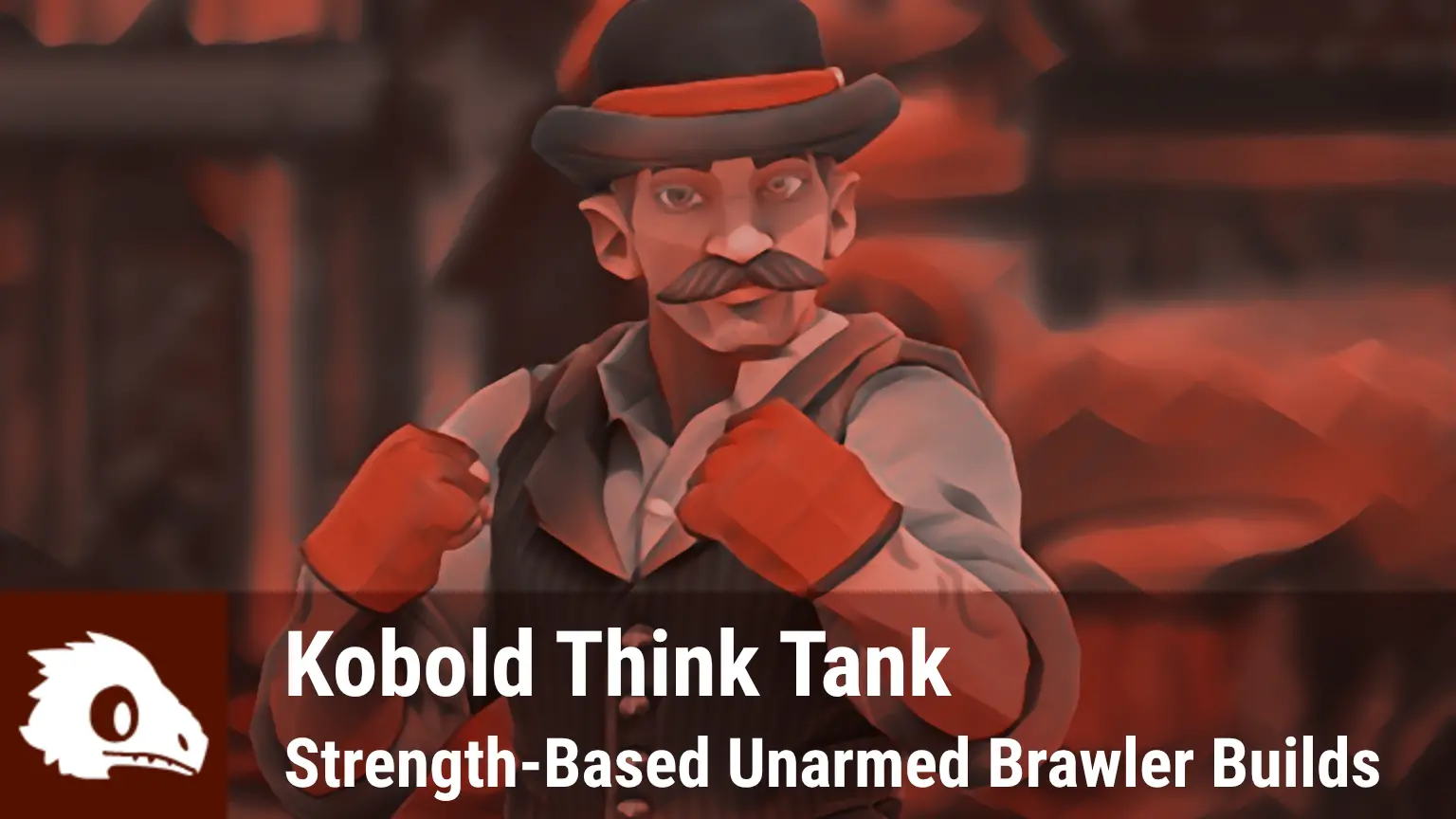Strength-Based Unarmed Brawler Builds in DnD 5e

Monks are great at a lot of things, but sometimes we want to build Mike Tyson rather than Bruce Lee. An unarmed Fighter offers several benefits, such as their staying power over long adventuring days and their strong ability to grapple opponents. It also opens up builds that don't have Wisdom as a cornerstone stat, allowing a character to be a charistmatic pugilist, or a cunning battlefield tactician. If you want to punch things and use Strength as your primary stat, this guide shows you how to do that in DnD 5e.
The Unarmed Fighting Style
Tasha’s Cauldron of Everything introduced a new fighting style that made unarmed builds much more enticing. The Unarmed fighting style, available exclusively to Fighters, lets you do 1d6 + Strength modifier damage with your unarmed attacks. If you’re not holding a weapon or shield, that goes up to 1d8. Also, at the start of each turn, you can deal 1d4 damage to each creature you’re grappling as a free action.
With this fighting style, your fists (or feet, or forehead) do damage comparable to most 1-handed martial weapons. The catch is that you can’t use a shield. There is the opportunity to do an extra 1d4 damage per turn for free, but this won’t compete with the raw damage output of a strong great weapon build. That’s OK. It’s fine to do things because you like the flavor, even if they’re not completely optimized. Fighters do a lot of damage to begin with, so it evens out.
What About Paladins, Rangers, and Barbarians?
This is where things get a little tricky. The Unarmed fighting style is not available to Paladins, Rangers, and Barbarians, but these classes can get it through multiclassing into Fighter, or with the Fighting Initiate feat. Does it work with other class features, though?
A tweet from lead game designer Jeremy Crawford in 2019 stated that unarmed attacks would not work with the Paladin’s smite. This statement pre-dates the release of Tasha’s and the Unarmed fighting style, so it’s unclear if the game design choice to make unarmed fighting more viable would change the answer.
It’s similarly unclear whether unarmed attacks would work with Ranger features like Hunter’s Mark. There’s no clear statement that it wouldn’t, but it hasn’t been stated to work either.
In both cases, the best thing to do is ask your DM before building a character for play. There’s no balance reason why it wouldn’t be good, so it’s purely a personal preference. Your DM may even allow Paladins and Rangers, who get a fighting style at level 2, to take the Unarmed fighting style even though it’s not technically available to them.
As for Barbarians, they’d have to multiclass or take a feat to get the fighting style (as Barbarians don’t get any fighting style through their class), but most Barbarian features would work with it.
Should I Grapple?
Grappling in 5e grants some strategic advantages, if you know how to use it. To grapple, you roll an Athletics check; whoever you’re trying to grapple rolls either Athletics or Acrobatics to contest it. If your opponent rolls lower than you, they are now grappled by you. On its own, grappling reduces an enemy’s movement speed to 0. That’s it. You can move the opponent, moving at half speed on your turn, but grappling does not give advantage on attacks (unless you took the Grappler feat).
Why would you use this? If an enemy keeps getting away from you (like an enemy who can fly or run up walls), this prevents them from fleeing out of reach. You may want to take advantage of effects in the field, or nullify enemy advantages from effects—for instance, dragging an enemy into the Cleric’s Spirit Guardians range and preventing them from fleeing, or grabbing an enemy that’s hiding in darkness and dragging them out into a brighter area so your allies can hit them more effectively.
One other nasty combination is with shoving. Shoving works much like grappling—you make an Athletics check, and the opponent contests it with either Athletics or Acrobatics. You can either shove an opponent away from you or down onto the ground. While an enemy is prone on the ground, all melee attacks against them are made with advantage. Here’s the trick: getting up from the ground takes half your movement. If your movement is 0 (like when you’re grappled), you can’t get up. So if you grapple and then shove an opponent, the only way they can get up is by beating you in an Athletics or Acrobatics check. If you have a few melee attackers in your party, this can turn the tables against a single opponent.
Unarmed Fighter Build Basics
Unarmed fighting for Fighter builds is Strength-based. (If you want a Dexterity-based brawler, choose a Monk.) So maxing Strength is the top priority for this build—it should be your highest stat, and you’ll spend your first few Ability Score Increases pumping it up to 20. Items that boost your Strength above 20, like Belts of Giant Strength or the Manual of Gainful Exercise, are great for this build.
The Unarmed fighting style also has a synergy with grappling, so proficiency in Athletics really helps. If you can get expertise in Athletics (through multiclassing or picking the Skill Expert feat), all the better. Taking a few levels of Barbarian will grant you advantage on all Strength checks—including Athletics checks to grapple an opponent—while raging.
Once you get past level 5, enemies that resist non-magical attacks become more common, and you have no innate way of making your unarmed attacks magical or magical weapons available to you. You’ll need one of two magic weapons:
- Eldritch Claw Tattoo - This is basically a +1 weapon for your fists, and gives an extra ranged attack once per day. Requires attunement.
- Insignia of Claws - This is also a +1 weapon for your fists, but grants no additional abilities. Does not require attunement.
You might also talk to your DM about homebrewing some magic weapons, like knuckle dusters or hand wraps.
For armor, heavy armor is generally considered the most optimal for Strength-based builds because light and medium armor require some Dexterity to be effective. If you feel your brawler should be decently dextrous as well, shooting for 14 Dexterity maxes out the benefit of medium armor, and grants several other important benefits, like bonuses to your initiative, several skills, and the fairly common Dexterity saving throws.
Fighter Subclasses for an Unarmed Build
Almost any Fighter subclass can work (sorry, Arcane Archer), but a few work better than the others.
Battle Master
The Battle Master’s fighting maneuvers will make an unarmed character feel like more of an expert combatant, but can also solve a few other problems for an unarmed character. Grappling Strike combines an attack with a grapple attempt, which can help grapplers keep up the damage. Many maneuvers will boost the damage on an attack, overcoming the slightly lower damage-per-attack that unarmed Fighters have compared to some other builds. The Battle Master is considered not only one of the best Fighter subclasses, but one of the better subclasses of any class, and it works well with unarmed builds.
Rune Knight
Harnessing primal magic from giants, the Rune Knight grants a toolkit of abilities that can be useful in combat. One big benefit that it gives unarmed builds, though, is the ability to grow one size larger. Going from a medium creature to a large creature grants a nice damage boost, but there’s one other important benefit. You can only grapple opponents who are one size larger than you, meaning that Huge and Gargantuan creatures can never be grappled by a medium-sized creature (like most player races). Growing one size larger will allow you to grapple larger opponents. Flying dragon harassing your party from the air? Not if you can grapple her. Rune Knights can eventually grow another size larger, or mages in your party may be able to cast Enlarge on you to grapple even the largest foes.
Eldritch Knight
The Eldritch Knight subclass grants a few simple spells to Fighters. Defensive spells like Absorb Elements and Shield will be your bread and butter and can help any Fighter build be a defensive powerhouse. Eldritch Knights get an ability to summon their chosen weapon to them if they’re ever separated, which may be wasted on an unarmed character (pro-tip: bond to a net!), but most of the other abilities will be of some use. The Eldritch Knight is great for more defensive builds, but adding some magic to your Fighter might be great flavor as well.
Feats for Unarmed Fighters
Crusher
The Crusher feat gives you a good bit of battlefield control, allowing you to essentially shove an opponent away from you for free. It also grants an additional benefit to critical hits and grants a +1 to either Strength or Constitution, making it a great fit for strength-based brawlers.
Skill Expert
+1 to a stat, plus expertise for your Athletics skill. This will make it extremely difficult for most opponents to escape your grapples.
Fey Touched
A few magic spells are great for any martial class, but there’s one spell that makes this feat especially valuable: Hex. This Warlock staple gives an extra 1d6 to every attack you make, potentially adding up to a lot of extra damage over the Fighter’s many attacks. You’ll need a pretty good Constitution score to keep your concentration as you take hits, but this can be a significant boost to your damage output when you need it.
Tavern Brawler
Once a staple for unarmed builds, the Tavern Brawler feat has lost some of its value since Tasha’s was released, but it still has one valuable thing for brawlers: the ability to grapple as a bonus action after you punch an opponent. That, plus a +1 to either Strength or Constitution, can make this a valuable feat to unarmed Fighters who need to round out an odd score in Strength or Constitution.
Fighting Initiate
Without a shield, lower AC might get you pretty beat up. With the Fighting Initiate feat, you can take the Defense fighting style for a permanent +1 to your armor class. That’s probably less important than other benefits on this list, but if you’re struggling with your armor class and your DM won’t give you better armor, this can help.
Magic Items for Unarmed Fighters
Eldritch Claw Tattoo/Insignia of Claws
Mentioned above, but without homebrewing, these two items are the only way for an unarmed Fighter to get magic damage with their attacks.
Belt of [Frost, Stone, Fire, Cloud, Storm] Giant Strength
With Strength being your most important stat, the ability to go over 20 is a huge benefit. It’s also the closest you’re going to get to a +[x] weapon without homebrewing.
Ring of Spell Storing
If you have a mage in your party who can recharge it for you, load this up with defensive spells like Shield and Absorb Elements, or have a Ranger or Warlock charge it with Hunter’s Mark or Hex for a damage boost.
